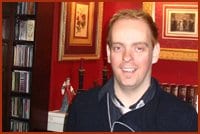Leaders of the drive to recognize a portion of Bank St as Ottawa’s gay village have released promising numbers that suggest the queer community is solidly behind the project.
Some 89 percent of respondents to an online survey by Glenn Crawford say they want to see official recognition for Ottawa’s gay strip, running from approximately Nepean to James. As well, respondents — to the tune of 86 percent — want the six-stripe rainbow flag to be used to denote the special character of the neighbourhood. And they want it called The Village.
Crawford, a gay businessman who lives in The Village area, collected 326 responses to questions ranging from the preferred name of the area to the type of signage Ottawans would like to see. The survey was conducted online throughout the fall and is not considered statistically accurate.
“Right away, from the number of people that took the time to fill out the survey and join the [500 users on the Rainbow Village] Facebook site, what that says is that there is an interest in our community. They’re saying, ‘We want this,’ ” says Crawford.
Ottawa’s queer community will be able to articulate itself directly to city planners in February. That’s because an open house is in the works, at which a proposal for the street’s redevelopment will be presented for citizens to give their input. A date for that meeting has not been finalized.
Crawford and his Facebook cohorts are looking to both city hall and the the Bank St BIA (Business Improvement Area) to help realize their goal of seeing rainbows on Bank street. If the City of Ottawa gets on board, the queer icon could grace anything from pavement markers to street signs. If the BIA incorporates the flag, it could appear on silk or canvas banners or other decorative elements of the revamped design.
“Both city hall and the BIA have been for the most part very supportive. The only quibble is where the boundary of The Village is,” says Crawford.
The results of the survey suggest Ottawa’s gays see the borders as fluid, but if the area is to be recognized, it’s going to have to have a definitive beginning and end points.
Richard Holder is the city planner in charge of redeveloping Bank St after the area from Laurier to Gladstone is torn up over the next two years to replace aging sewers.
The city pays for “basic” streetscaping, while the BIA tops up the fund for extra beautification, says Holder.
“The BIA is providing the direction in terms of branding,” says Holder, but he adds that there’s a public consultation process that will help firm up the route the city takes.
That puts the onus back on people to attend the February open house to make their opinions known to planners.
In the meantime, a group of about 15 citizens has met twice at the request of the city to give their thoughts on the project. Crawford is one. He’s joined on the Public Advisory Committee (PAC) by Ricky Barnes from Pink Triangle Services.
“With the PAC, it’s important that we get in and we get people to recognize that this is the downtown of the queer community,” says Barnes. “It’s one of the pieces that will come together inevitably to form the Village.”
The character and branding were not extensively discussed at the November meeting, because disagreements over parking, bus stop locations and business loading zones took up the bulk of the time. Another PAC is planned for January.
Members of the PAC now have copies of Crawford’s survey and some planners have sat down for one-on-one meetings with Crawford.
Barnes points out that there are other ways for the neighbourhood to be officially recognized for its queer residents. There’s a clutch of documents — from neighborhood plans to large-scale vision documents — that should be amended to include a rainbow designation for the Bank St corridor.
But simple visual cues installed after the construction is finished remains the simplest and most viable way to make the area identifiably queer friendly.
The city has earmarked one percent of the redevelopment budget to public art. Since Capital Xtra announced news of a city-sponsored statue project in Sep, some of those details have now been nailed down, according to Karen Nesbitt, the woman in charge of the public art aspect of the city plan.
In the new year, the city will call for designs from artists with the goal of producing between 10 and 30 designs in metal, attached to bike racks. The designs will repeat on 90 racks distributed between Laurier and the Queensway.
“We’ll actually make them, but we’re asking artists to design them,” says Nesbitt.
That means that the pool of potential contributors to the project is considerably wider than if a statue were to be built by a sculptor. Painters, graphic designers, or anyone else who’s interested could conceivably contribute winning designs.
“We’re going to be encouraging queer artists. We’re fully expecting to be represented,” in the designs, says Barnes.
Both Barnes and Crawford suggested queer themes ought to be represented.
The final format and exact dimensions will be determined after the bike racks are chosen — which means after February’s open house.
Gerry Lepage, director of the Bank St BIA, did not return calls by press time.


 Why you can trust Xtra
Why you can trust Xtra


